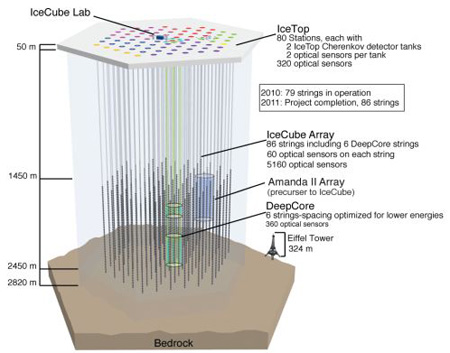IceCube Neutrino Observatory

The IceCube lab near the US Amundsen-Scott South Pole Station. Image credit: NSF/S. Lidstrom.

The IceCube array of detectors. Note the Eiffel Tower at bottom right for comparison. Image credit: NSF/J. Yang.
Eight thousand feet below the ice at the South Pole is one of the largest observatories on Earth. It isn't built to detect light, infrared, ultraviolet, or any other kind of electromagnetic radiation. IceCube, as this strange scientific instrument is known, is designed to capture the most elusive particles known in nature – neutrinos – which for the most part can pass clean through our planet as if it were empty space.
Neutrinos are produced by ordinary stars, such as the Sun. But they are generated in the greatest numbers and at the highest energies by some of the most violent events in the universe, including supernovae and colliding galaxies. By building detectors that can pick up neutrinos coming from such phenomena, scientists are opening up an entirely new window on the cosmos, independent of the electromagnetic spectrum.
How IceCube works
Completed in 2010 at a cost of $279 million, the bulk of which came from the US National Science Foundation, IceCube works not by detecting neutrinos directly. Instead it detects light flashes from muons, which are particles created when neutrinos very occasionally collide with water molecules in the thick layer of Antarctic ice above the detector. After being formed in such collisions, the muons travel through the ice faster than the speed of light on ice, which causes them to emit a kind of light called Cerenkov radiation. This is then detector by the array of optical sensors that form the main part of part of the IceCube Observatory.
Each sensor, called a Digital Optical Module (DOM), consists of a photomultiplier tube and a small computer for processing the signal. The DOMs are attached to "strings" of 60 modules each at depths ranging from 1,450 meters to 2,2450 meters, in long cylindrical holes that were melted through the ice using a hot water drill. With 86 strings, the complete IceCube array has 5,160 individual optical sensors.
The gamma-ray burst puzzle
One of the great outstanding mysteries of astrophysics is the origin of the highest energy cosmic rays – mostly fast-moving protons with up to a million times more energy than anything the Large Hadron Collider can produce. Only the most extreme environments in the universe could give rise to such extraordinarily energetic particles. Scientists had two main suspects: the regions around supermassive black holes at the centers of active galaxies, and unbelievably powerful eruptions of matter and radiation known as gamma-ray bursts (GRBs).
Theory suggested that along with cosmic rays, GRBs should produce a bright flux of neutrinos, which IceCube would be capable of detecting. Researchers used IceCube to search for neutrinos from 300 gamma-ray bursts observed between May 2008 and April 2010 in coincidence with the Swift Gamma-ray Burst Explorer and Fermi Gamma-ray Space Telescope. In the April 19 issue of the journal Nature, they published their results. No neutrinos were found to correlate with any of the GRB events, suggesting that GRBs are not a significant source of high-energy cosmic rays either.


